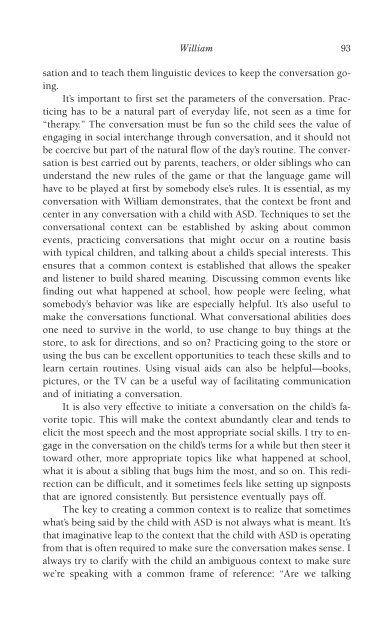978-1572305441
autism
autism
Create successful ePaper yourself
Turn your PDF publications into a flip-book with our unique Google optimized e-Paper software.
William 93<br />
sation and to teach them linguistic devices to keep the conversation going.<br />
It’s important to first set the parameters of the conversation. Practicing<br />
has to be a natural part of everyday life, not seen as a time for<br />
“therapy.” The conversation must be fun so the child sees the value of<br />
engaging in social interchange through conversation, and it should not<br />
be coercive but part of the natural flow of the day’s routine. The conversation<br />
is best carried out by parents, teachers, or older siblings who can<br />
understand the new rules of the game or that the language game will<br />
have to be played at first by somebody else’s rules. It is essential, as my<br />
conversation with William demonstrates, that the context be front and<br />
center in any conversation with a child with ASD. Techniques to set the<br />
conversational context can be established by asking about common<br />
events, practicing conversations that might occur on a routine basis<br />
with typical children, and talking about a child’s special interests. This<br />
ensures that a common context is established that allows the speaker<br />
and listener to build shared meaning. Discussing common events like<br />
finding out what happened at school, how people were feeling, what<br />
somebody’s behavior was like are especially helpful. It’s also useful to<br />
make the conversations functional. What conversational abilities does<br />
one need to survive in the world, to use change to buy things at the<br />
store, to ask for directions, and so on? Practicing going to the store or<br />
using the bus can be excellent opportunities to teach these skills and to<br />
learn certain routines. Using visual aids can also be helpful—books,<br />
pictures, or the TV can be a useful way of facilitating communication<br />
and of initiating a conversation.<br />
It is also very effective to initiate a conversation on the child’s favorite<br />
topic. This will make the context abundantly clear and tends to<br />
elicit the most speech and the most appropriate social skills. I try to engage<br />
in the conversation on the child’s terms for a while but then steer it<br />
toward other, more appropriate topics like what happened at school,<br />
what it is about a sibling that bugs him the most, and so on. This redirection<br />
can be difficult, and it sometimes feels like setting up signposts<br />
that are ignored consistently. But persistence eventually pays off.<br />
The key to creating a common context is to realize that sometimes<br />
what’s being said by the child with ASD is not always what is meant. It’s<br />
that imaginative leap to the context that the child with ASD is operating<br />
from that is often required to make sure the conversation makes sense. I<br />
always try to clarify with the child an ambiguous context to make sure<br />
we’re speaking with a common frame of reference: “Are we talking



